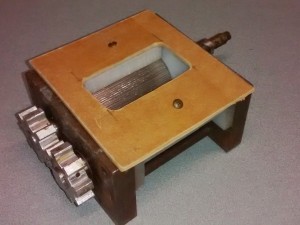So I recently started working on an old project of mine, a motorized grain mill. Being an (somewhat) avid home brewer, I have need of a mill from time to time. Also being an (somewhat) avid DIY enthusiast, I wanted to design and build my own. Finally, being an (entirely) broke-as-a-joke-fool, I didn’t want to spend any money on it. Luckily for me, I work in a machine shop, and from time to time I’m able to pick up scrap for next to nothing. Or, if the boss is feeling charitable, actually nothing. I didn’t take any photos of the process of building the actual mill, but as I start building the hopper, motor adapter, and stand I’ll try to document what I’m doing.
So here’s my grain mill:
To start with I found some 1.75″ 17-4 SS, and used it to make the rollers. My original idea was to put grooves in one roller, and leave the other smooth. Most of the commercialy available mills have knurling on both rollers; My thinking was that the smooth roller would keep the barley husk from getting shredded, while still breaking up the kernel. The downside to this design is that there wouldn’t be enough friction on the smooth roller to keep it turning. Commercial mills have one driven roller; the other roller spins free, and is only turned by the grain being smashed between the rollers. To compensate for this I made a couple of gears out of aluminium, so that both rollers would be driven. As it turns out, having a smooth roller did give me a good crush on the malt, and the gears kept both rollers spinning. However, The smooth roller doesn’t have enough grip to pull grain into the gap. To overcome this, I have to push grain into the roller every time I use it. Which is tedious, to say the least.
So, the other day I took the mill apart, and took the smooth roller to the shop. I set up and knurled it. I cleaned it up, put it back together, and started working on a new hoppper. Soon I should have it ready to crush another few pounds of grain so that I can make some more liquid barley. In my next post I’m going to talk about what I’m doing to drive the mill, so stay tuned.
Cheers!
